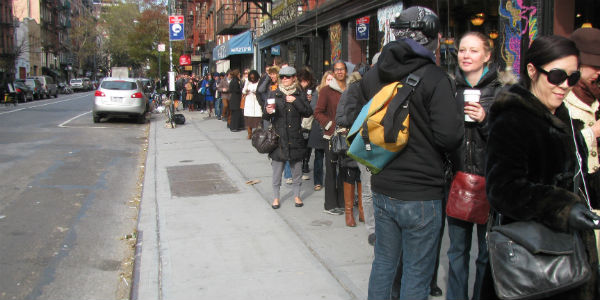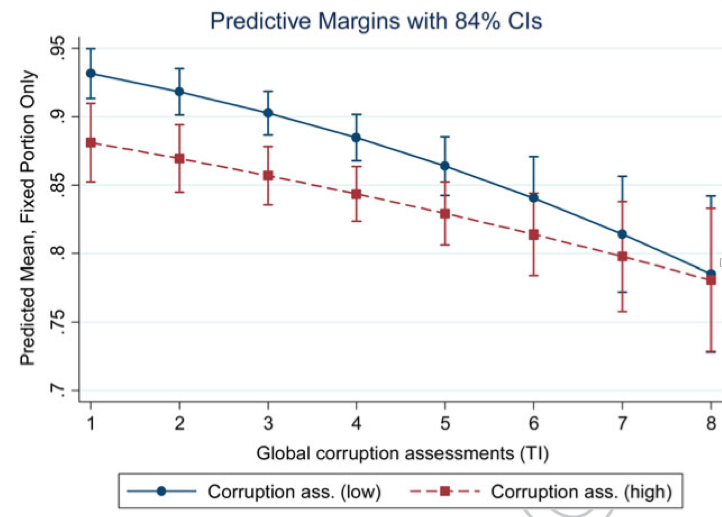Does political corruption put people off voting? (Not if it’s really bad)
If you think the politicians in your country are corrupt, are you less likely to turn out to vote? Some studies suggest you are. Others find the opposite – perhaps because corrupt politicians will say anything to get re-elected, and their promises motivate voters. Stefan Dahlberg and Maria Solevid found that perceived corruption does indeed deter voters – unless they live in countries where corruption is endemic. Turnout is still lower in these places, but not because voters are put off by corruption.

People in the East Village, New York queue to vote in November 2012. Photo: Eden, Janine and Jim via a CC-BY 2.0 licence
A basic principle of representative democracy is that voters actively choose their political representatives, and that those representatives act in accordance with the voters’ interests. If the elected government fails to do that, voters hold it to account by voting the politicians out of office in the next elections. So voter participation, or turnout, is one of the most important indicators of how legitimate a democratic system really is. Briefly put: the higher the turnout, the better a democracy is considered to be functioning. But what happens when the link between voters and their elected representatives is destroyed by corruption?
The fact that corruption has many negative effects on society is well-established. Research has shown that countries with high corruption levels have lower economic growth, higher infant mortality and lower levels of interpersonal trust. But when it comes to the question of how corruption affects voters’ propensity to vote, the answers have so far been unclear. Some research suggests that corruption may actually increase turnout. One reason for this is that the corrupt politicians who want to be re-elected are campaigning more intensively and thereby mobilise more voters. Another is that in countries with widespread corruption, and where the relationship between the voter and the elected representative is essentially one of clientelism, politicians buy votes by promising (and delivering) things that are important to their voters.
Yet other research shows that the presence of corruption decreases turnout. Both studies at the aggregate level (a comparison of countries over time) and studies at the individual level (comparison of the voters) have shown that corruption implies lower turnout. This is because the presence of corruption implies a weak and inefficient allocation of public goods. In turn, this means voters lose faith in the political system and see no point in voting.
In a recent article, Maria Solevid and I investigated the relationship between voters’ perceptions of political corruption and – more specifically – whether the decision to vote or not varies depending on the degree of systemic corruption in the country. Previous studies of corruption and voter turnout did not look at this combination of micro and macro explanations. By studying how corruption perceptions affect turnout and how the relationship is affected by systemic corruption, we can get a more comprehensive answer to the question of how corruption affects turnout.
In the article we test two hypotheses:
1) the more the political corruption voters perceive, the lower the turnout
2) the more political corruption voters perceive, the lower the turnout in countries with high systemic corruption compared to countries with low systemic corruption.
To investigate the relationship and test the hypotheses, we have used individual level data from the Comparative Study of Electoral Systems together with context data from the Quality of Government Institute. Overall, we studied voters in 26 countries. A relevant question here is whether, in countries with high levels of corruption, voters’ perceptions of it vary? The answer is yes.
Firstly – after controlling for well-established individual-level explanations of voter turnout such as gender, age, education, party identification and political knowledge and compulsory voting at the system level – we found voters’ perceptions of corruption have a significant negative effect on turnout, supporting the first hypothesis. After controlling for other factors and on average in the countries we studied, voters who believe political corruption to be widespread are on average 8 percentage points less likely to vote compared to voters who do not perceive any corruption at all. (The predicted probability of voting among voters who perceive corruption as widespread is 82 percent; among voters who do not perceive any corruption at all, it is 90 percent).
But as we continued to examine the relationship between perceptions of corruption and turnout, it appeared that the relationship was only valid in countries with low (eg Sweden, the Netherlands) or medium (eg Spain, Hungary) levels of corruption. This is the opposite of what we expected under the second hypothesis. The result is illustrated in Figure 1.
Figure 1: Interaction effect between corruption perceptions and global corruption turnout (predicted probabilities).

Comment: Blue solid line corresponds to voters who perceives no political corruption. Red dotted line corresponds voter who perceives political corruption to be widespread. X axis consists of Transparency International’s Corruption Perceptions Index, but the scale is reversed so the higher the values, the greater is the corruption. The y-axis measures the predicted likelihood to vote and is interpreted as percent (1 = 100% likely to vote). The model is based on a multilevel logistic regression with varying intercept and slope (Global Corruption).
In countries with high levels of corruption (such as Romania, Bulgaria, Peru and Mexico) there is no statistically significant relationship between the perception of corruption and turnout. In other words, voters in highly corrupt countries vote just as much, regardless of whether they think corruption is widespread or not. So voter turnout is already lower among “all” voters in these highly corrupt countries.
We concluded that corruption does indeed lower turnout – but in different ways depending on the context under investigation. In countries with relatively low levels of corruption, the voter’s own perceptions play a more decisive role when they are deciding whether to vote. In countries with relatively high levels of corruption, voter turnout is already lower and perceived corruption does not make the individual any less likely to vote. There are therefore other explanations for low turnout in these states.
This post represents the views of the author and not those of Democratic Audit. It is based on Dahlberg, Stefan and Maria Solevid (2016). ”Does corruption suppress voter turnout?” Journal of Elections, Public Opinion and Parties, 26:4.

 Stefan Dahlberg is Associate Professor in Political Science and a Database Manager at the Quality of Government Institute. He is also connected to the Swedish National Election Study program and the Multidisciplinary Opinion and Democracy Research Group (MOD) at the University of Gothenburg.
Stefan Dahlberg is Associate Professor in Political Science and a Database Manager at the Quality of Government Institute. He is also connected to the Swedish National Election Study program and the Multidisciplinary Opinion and Democracy Research Group (MOD) at the University of Gothenburg.
Maria Solevid is a senior lecturer at the Department of Political Science at the University of Gothenburg and a principal investigator at the SOM Institute. She is also a member of the Swedish National Election Studies Program.





 Democratic Audit's core funding is provided by the Joseph Rowntree Charitable Trust. Additional funding is provided by the London School of Economics.
Democratic Audit's core funding is provided by the Joseph Rowntree Charitable Trust. Additional funding is provided by the London School of Economics.
[…] article was originally published on the Democratic […]